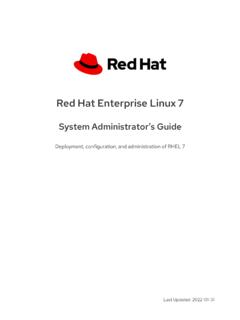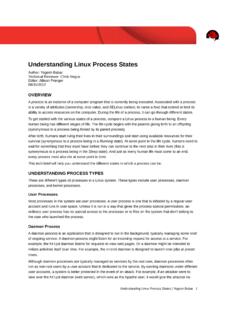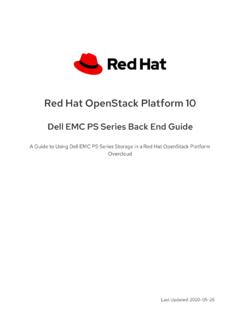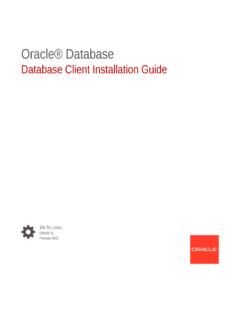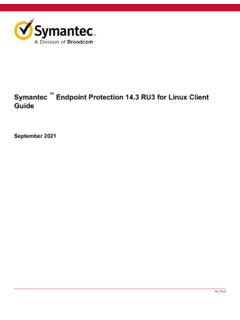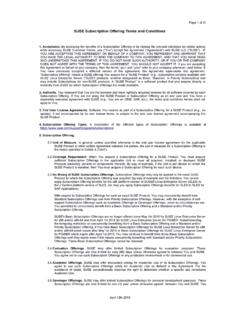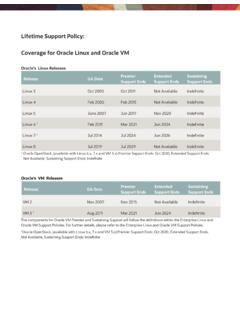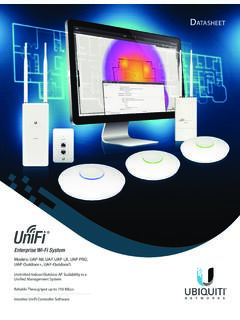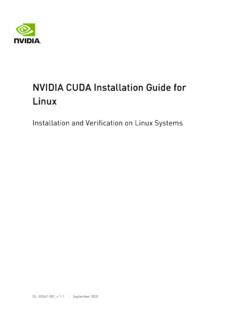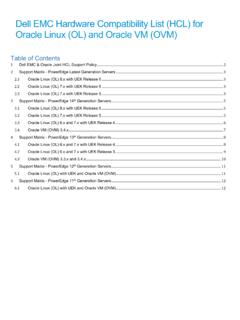Transcription of Red Hat Enterprise Linux Network Performance Tuning Guide
1 Red Hat Enterprise Linux Network Performance Tuning GuideAuthors: Jamie Bainbridge and Jon Maxwell Reviewer: Noah DavidsEditors: Dayle Parker and Chris Negus03/25/2015 Tuning a Network interface card (NIC) for optimum throughput and latency is a complex process with many factors to factors include capabilities of the Network interface, driver features and options, the systemhardware that Red Hat Enterprise Linux is installed on, CPU-to-memory architecture, amount of CPU cores, the version of the Red Hat Enterprise Linux kernel which implies the driver version, not to mention the workload the Network interface has to handle, and which factors (speed or latency) are most important to that is no generic configuration that can be broadly applied to every system, as the above factors are always aim of this document is not to provide specific Tuning information, but to introduce the reader to the process of packet reception within the Linux kernel, then to demonstrate available Tuning methods which can be applied to a given RECEPTION IN THE Linux KERNELThe NIC ring bufferReceive ring buffers are shared between the device driver and NIC.
2 The card assigns a transmit (TX) and receive (RX) ring buffer. As the name implies, the ring buffer is a circular buffer where anoverflow simply overwrites existing data. It should be noted that there are two ways to move data from the NIC to the kernel, hardware interrupts and software interrupts, also called RX ring buffer is used to store incoming packets until they can be processed by the device driver. The device driver drains the RX ring, typically via SoftIRQs, which puts the incoming packets into a kernel data structure called an sk_buff or skb to begin its journey through the kernel and up to the application which owns the relevant socket. The TX ring buffer is used to hold outgoing packets which are destined for the ring buffers reside at the bottom of the stack and are a crucial point at which packet drop can occur, which in turn will adversely affect Network and Interrupt HandlersInterrupts from the hardware are known as top-half interrupts.
3 When a NIC receives incoming data, it copies the data into kernel buffers using DMA. The NIC notifies the kernel of this data by Red Hat Enterprise Linux Network Performance Tuning Guide | Bainbridge, Maxwell 1raising a hard interrupt. These interrupts are processed by interrupt handlers which do minimal work, as they have already interrupted another task and cannot be interrupted themselves. Hard interrupts can be expensive in terms of CPU usage, especially when holding kernel hard interrupt handler then leaves the majority of packet reception to a software interrupt, or SoftIRQ, process which can be scheduled more interrupts can be seen in /proc/interrupts where each queue has an interrupt vector inthe 1st column assigned to it. These are initialized when the system boots or when the NIC devicedriver module is loaded. Each RX and TX queue is assigned a unique vector, which informs the interrupt handler as to which NIC/queue the interrupt is coming from.
4 The columns represent the number of incoming interrupts as a counter value:# egrep CPU0|eth2 /proc/interrupts CPU0 CPU1 CPU2 CPU3 CPU4 CPU5 105: 141606 0 0 0 0 0 IR-PCI-MSI-edge eth2-rx-0 106: 0 141091 0 0 0 0 IR-PCI-MSI-edge eth2-rx-1 107: 2 0 163785 0 0 0 IR-PCI-MSI-edge eth2-rx-2 108: 3 0 0 194370 0 0 IR-PCI-MSI-edge eth2-rx-3 109: 0 0 0 0 0 0 IR-PCI-MSI-edge eth2-txSoftIRQsAlso known as bottom-half interrupts, software interrupt requests (SoftIRQs) are kernel routines which are scheduled to run at a time when other tasks will not be interrupted. The SoftIRQ's purpose is to drain the Network adapter receive ring buffers. These routines run in the form of ksoftirqd/cpu-number processes and call driver-specific code functions.
5 They can be seen in process monitoring tools such as ps and following call stack, read from the bottom up, is an example of a SoftIRQ polling a Mellanox card. The functions marked [mlx4_en] are the Mellanox polling routines in the driver kernel module, called by the kernel's generic polling routines such as net_rx_action. After moving from the driver to the kernel, the traffic being received will then move up to the socket, ready for the application to consume: mlx4_en_complete_rx_desc [mlx4_en] mlx4_en_process_rx_cq [mlx4_en] mlx4_en_poll_rx_cq [mlx4_en] net_rx_action __do_softirq run_ksoftirqd smpboot_thread_fn kthread kernel_thread_starter kernel_thread_starter 1 lock held by ksoftirqdRed Hat Enterprise Linux Network Performance Tuning Guide | Bainbridge, Maxwell 2 SoftIRQs can be monitored as follows. Each column represents a CPU:# watch -n1 grep RX /proc/softirqs# watch -n1 grep TX /proc/softirqsNAPI PollingNAPI, or New API, was written to make processing packets of incoming cards more efficient.
6 Hard interrupts are expensive because they cannot be interrupted. Even with interrupt coalescence (described later in more detail), the interrupt handler will monopolize a CPU core completely. The design of NAPI allows the driver to go into a polling mode instead of being hard-interrupted for every required packet normal operation, an initial hard interrupt or IRQ is raised, followed by a SoftIRQ handler which polls the card using NAPI routines. The polling routine has a budget which determines the CPU time the code is allowed. This is required to prevent SoftIRQs from monopolizing the CPU. On completion, the kernel will exit the polling routine and re-arm, then the entire procedure will repeat : SoftIRQ mechanism using NAPI poll to receive dataNetwork Protocol StacksOnce traffic has been received from the NIC into the kernel, it is then processed by protocol handlers such as Ethernet, ICMP, IPv4, IPv6, TCP, UDP, and Hat Enterprise Linux Network Performance Tuning Guide | Bainbridge, Maxwell 2015 Red Hat, Inc.
7 Red Hat, Red Hat Linux , the Red Hat Shadowman logo, and the products listed are trademarks of Red Hat, Inc., registered in the and other countries. Linux is the registered trademark of Linus Torvalds in the and other , the data is delivered to a socket buffer where an application can run a receive function, moving the data from kernel space to userspace and ending the kernel's involvement in the receive egress in the Linux kernelAnother important aspect of the Linux kernel is Network packet egress. Although simpler than the ingress logic, the egress is still worth acknowledging. The process works when skbs are passed down from the protocol layers through to the core kernel Network routines. Each skb contains a dev field which contains the address of the net_device which it will transmitted through:int dev_queue_xmit(struct sk_buff *skb){ struct net_device *dev = skb->dev; <--- here struct netdev_queue *txq; struct Qdisc *q;It uses this field to route the skb to the correct device: if (!)}
8 Dev_hard_start_xmit(skb, dev, txq)) {Based on this device, execution will switch to the driver routines which process the skb and finallycopy the data to the NIC and then on the wire. The main Tuning required here is the TX queueing discipline (qdisc) queue, described later on. Some NICs can have more than one TX queue. The following is an example stack trace taken from a test system. In this case, traffic was going via the loopback device but this could be any NIC module: 0xffffffff813b0c20 : loopback_xmit+0x0/0xa0 [kernel] 0xffffffff814603e4 : dev_hard_start_xmit+0x224/0x480 [kernel] 0xffffffff8146087d : dev_queue_xmit+0x1bd/0x320 [kernel] 0xffffffff8149a2f8 : ip_finish_output+0x148/0x310 [kernel] 0xffffffff8149a578 : ip_output+0xb8/0xc0 [kernel] 0xffffffff81499875 : ip_local_out+0x25/0x30 [kernel] 0xffffffff81499d50 : ip_queue_xmit+0x190/0x420 [kernel] 0xffffffff814af06e : tcp_transmit_skb+0x40e/0x7b0 [kernel] 0xffffffff814b0ae9 : tcp_send_ack+0xd9/0x120 [kernel] 0xffffffff814a7cde : __tcp_ack_snd_check+0x5e/0xa0 [kernel] 0xffffffff814ad383 : tcp_rcv_established+0x273/0x7f0 [kernel] 0xffffffff814b5873 : tcp_v4_do_rcv+0x2e3/0x490 [kernel] 0xffffffff814b717a : tcp_v4_rcv+0x51a/0x900 [kernel] 0xffffffff814943dd.}
9 Ip_local_deliver_finish+0xdd/0x2d0 [kernel] 0xffffffff81494668 : ip_local_deliver+0x98/0xa0 [kernel] 0xffffffff81493b2d : ip_rcv_finish+0x12d/0x440 [kernel] 0xffffffff814940b5 : ip_rcv+0x275/0x350 [kernel] 0xffffffff8145b5db : __netif_receive_skb+0x4ab/0x750 [kernel] 0xffffffff8145b91a : process_backlog+0x9a/0x100 [kernel] 0xffffffff81460bd3 : net_rx_action+0x103/0x2f0 [kernel] Red Hat Enterprise Linux Network Performance Tuning Guide | Bainbridge, Maxwell 4 Networking ToolsTo properly diagnose a Network Performance problem, the following tools can be used:netstatA command-line utility which can print information about open Network connections and protocol stack statistics. It retrieves information about the networking subsystem from the /proc/net/ file system. These files include: /proc/net/dev (device information) /proc/net/tcp (TCP socket information) /proc/net/unix (Unix domain socket information) For more information about netstat and its referenced files from /proc/net/, refer to the netstat man page: man netstat.
10 DropwatchA monitoring utility which monitors packets freed from memory by the kernel. For more information, refer to the dropwatch man page: man dropwatch. ipA utility for managing and monitoring routes, devices, policy routing, and tunnels. For more information, refer to the ip man page: man ip. ethtoolA utility for displaying and changing NIC settings. For more information, refer to the ethtool man page: man ethtool. /proc/net/snmpA file which displays ASCII data needed for the IP, ICMP, TCP, and UDP management informationbases for an snmp agent. It also displays real-time UDP-lite statistics. For further details see: ifconfig command uses older-style IOCTLs to retrieve information from the kernel. This method is outdated compared to the ip command which uses the kernel's Netlink interface. Use of the ifconfig command to investigate Network traffic statistics is imprecise, as the statistics are not guaranteed to be updated consistently by Network drivers.






